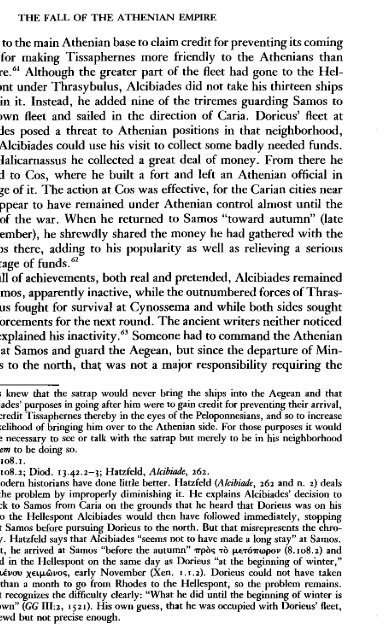The Fall of the Athenian Empire-(A New History of the Peloponnesian War) Donald Kagan - (1987)
MACEDONIA is GREECE and will always be GREECE- (if they are desperate to steal a name, Monkeydonkeys suits them just fine) ΚΑΤΩ Η ΣΥΓΚΥΒΕΡΝΗΣΗ ΤΩΝ ΠΡΟΔΟΤΩΝ!!! Strabo – “Geography” “There remain of Europe, first, Macedonia and the parts of Thrace that are contiguous to it and extend as far as Byzantium; secondly, Greece; and thirdly, the islands that are close by. Macedonia, of course, is a part of Greece, yet now, since I am following the nature and shape of the places geographically, I have decided to classify it apart from the rest of Greece and to join it with that part of Thrace which borders on it and extends as far as the mouth of the Euxine and the Propontis. Then, a little further on, Strabo mentions Cypsela and the Hebrus River, and also describes a sort of parallelogram in which the whole of Macedonia lies.” (Strab. 7.fragments.9) ΚΚΕ, ΚΝΕ, ΟΝΝΕΔ, ΑΓΟΡΑ,ΕΚΚΛΗΣΙΑ,ΝΕΑ,ΦΩΝΗ,ΦΕΚ,ΝΟΜΟΣ,LIFO,MACEDONIA, ALEXANDER, GREECE,IKEA
MACEDONIA is GREECE and will always be GREECE- (if they are desperate to steal a name, Monkeydonkeys suits them just fine)
ΚΑΤΩ Η ΣΥΓΚΥΒΕΡΝΗΣΗ ΤΩΝ ΠΡΟΔΟΤΩΝ!!!
Strabo – “Geography”
“There remain of Europe, first, Macedonia and the parts of Thrace that are contiguous to it and extend as far as Byzantium; secondly, Greece; and thirdly, the islands that are close by. Macedonia, of course, is a part of Greece, yet now, since I am following the nature and shape of the places geographically, I have decided to classify it apart from the rest of Greece and to join it with that part of Thrace which borders on it and extends as far as the mouth of the Euxine and the Propontis. Then, a little further on, Strabo mentions Cypsela and the Hebrus River, and also describes a sort of parallelogram in which the whole of Macedonia lies.”
(Strab. 7.fragments.9)
ΚΚΕ, ΚΝΕ, ΟΝΝΕΔ, ΑΓΟΡΑ,ΕΚΚΛΗΣΙΑ,ΝΕΑ,ΦΩΝΗ,ΦΕΚ,ΝΟΜΟΣ,LIFO,MACEDONIA, ALEXANDER, GREECE,IKEA
You also want an ePaper? Increase the reach of your titles
YUMPU automatically turns print PDFs into web optimized ePapers that Google loves.
230 THE FALL OF THE ATHENIAN EMPIRE<br />
when <strong>the</strong> fleet <strong>of</strong> Mindarus slipped by Thrasyllus to <strong>the</strong> Hellespont.<br />
Keeping <strong>the</strong> A<strong>the</strong>nian navy at Samos against such a move had been<br />
crucial not only for A<strong>the</strong>ns' own interests but also for Tissaphernes'<br />
plan. He could engage in insolent deceptions and break his promises<br />
at will as long as <strong>the</strong> A<strong>the</strong>nians barred <strong>the</strong> way north. <strong>The</strong>ir failure<br />
to do so changed everything. Tissaphernes hurried to complain <strong>of</strong> <strong>the</strong><br />
assistance to Antandrus, make a defense against <strong>the</strong> charges lodged<br />
against him, and try to salvage something from <strong>the</strong> disaster that threatened<br />
his interests. 68<br />
At dawn on a day early in November, Dorieus sailed toward <strong>the</strong><br />
mouth <strong>of</strong> <strong>the</strong> Hellespont with his fourteen ships from Rhodes. 69 He<br />
probably had hoped to slip by <strong>the</strong> A<strong>the</strong>nian lookouts under cover <strong>of</strong><br />
darkness, as he may well have done to get by Alcibiades at Samos,<br />
but his timing was <strong>of</strong>f, and he was seen sailing past Sigeum (see Map<br />
8) at daybreak. <strong>The</strong> watchman signaled <strong>the</strong> news <strong>of</strong> his arrival to <strong>the</strong><br />
A<strong>the</strong>nian generals at Sestos who swiftly sent a squadron <strong>of</strong> twenty<br />
triremes to cut him <strong>of</strong>f. When Dorieus saw <strong>the</strong> A<strong>the</strong>nian ships bearing<br />
down on him, he fled to <strong>the</strong> shore and pulled his ships up on <strong>the</strong> beach<br />
near Rhoeteum. <strong>The</strong> A<strong>the</strong>nians pursued but were not prepared to<br />
prolong what amounted to a battle on land. <strong>The</strong>y withdrew to Madytus,<br />
where <strong>the</strong>y joined <strong>the</strong> rest <strong>of</strong> <strong>the</strong>ir fleet, which by this time was<br />
at sea and ready to fight. From <strong>the</strong>re <strong>the</strong> whole fleet was in a better<br />
position than from Sestos to prevent <strong>the</strong> squadron <strong>of</strong> Dorieus from<br />
joining <strong>the</strong> main <strong>Peloponnesian</strong> fleet at Abydos. When Dorieus saw<br />
<strong>the</strong> A<strong>the</strong>nian squadron withdraw, he resumed his course up <strong>the</strong> Hellespont<br />
toward Abydos, but soon he was attacked again, this time by<br />
<strong>the</strong> entire A<strong>the</strong>nian force <strong>of</strong> seventy-four ships. 70 Overwhelmingly<br />
outnumbered, he had no choice but to put in to land at <strong>the</strong> first likely<br />
place, which was Dardanus. He pulled his ships onto <strong>the</strong> beach, dis-<br />
688.109.<br />
69 Xen. 1.1. z; Oiod. 1 3·45 .2. Busolt's reconstruction <strong>of</strong> <strong>the</strong> battle <strong>of</strong> Abydos (GG<br />
Ill:z, 1522-152 3) is based entirely on <strong>the</strong> account <strong>of</strong> Xenophon (1. 1. 2-7); he regards<br />
<strong>the</strong> account <strong>of</strong> Diodorus as merely a transcription <strong>of</strong> that <strong>of</strong> Ephorus and considers it<br />
worthless (GG III:z, IpJ, n. 1). We now have reason to believe that Diodorus may<br />
also have had <strong>the</strong> Helknica Oxyrhynchia as a source-and a good one-for this period.<br />
Moreover, we cannot be sure that he had no o<strong>the</strong>r good sources. His account is fuller<br />
and, to my mind, more satisfactory than Xenophon's, although <strong>the</strong> latter seems to have<br />
some accurate information omitted by Diodorus. Grote (VIII, 1 1 7), without <strong>the</strong> benefi£<br />
<strong>of</strong> valuable informa£ion available to us, none<strong>the</strong>less constructed his account from a<br />
combination <strong>of</strong> <strong>the</strong> two amhors, rightly, I think.<br />
70<br />
Diod. IJ·45·Z-J. Diodorus' numbers here are entirely plausible. After Cynossema<br />
<strong>the</strong> A<strong>the</strong>nians had sixty-one ships; <strong>the</strong>y captured eighr more in <strong>the</strong> Propontis, and<br />
Thymochares may well have brought <strong>the</strong>m· five more.

















